The most common type of finger dislocation – this usually involves injury to the volar plate and may include a volar plate avulsion fracture
Healing
This injury can take between 6-12 weeks to heal fully.
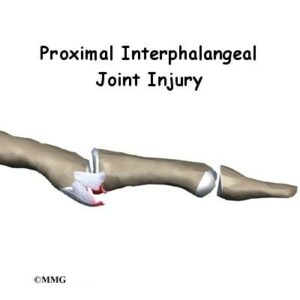
Smoking will slow down your healing. We would advise that you stop smoking while your injury heals. Talk to your GP or go to www.smokefree.nhs.uk for more information.
Pain and Swelling
It is normal after an injury to have swelling. Swelling can make your finger stiff and make moving your finger more difficult. In the initial stages it is advised not to leave your hand lower than your heart for long periods as this can encourage swelling into this area.
Painkillers are important to aid your recovery and should be used as required. Stop non-steroidal anti-inflammatory drugs (NSAIDS) e.g. Ibuprofen after 5-7 days as this will slow bone healing. You may find it continues to be a bit achy and swollen for a few months after your injury. An ice pack will help initially with pain and swelling (make sure the ice is not in direct contact with the skin).
Follow up
Patients with this condition are not routinely followed up by the Fracture clinic but will be referred to the Hand Therapy Department for further care. If you have not heard from the Hand Therapy Team within one week please contact the Virtual Fracture Clinic.
Caring for your injury: Splinting
Splint/strapping:
You may be provided with buddy taping or some form of splint.
A splint is made to prevent your finger fully extending and to protect the injured ligaments.
This must be worn 24 hours a day for 6 weeks. The rest of your hand will be left free for you to use for light activities.
The finger may be held bent and slowly straightened over time allowing the injury to heal. You will be advised by the hand therapist to slowly commence movement within the restraints of the splint.
The aim is to get the finger moving as soon as possible to prevent stiffness. Simple painkillers will help you move the finger.
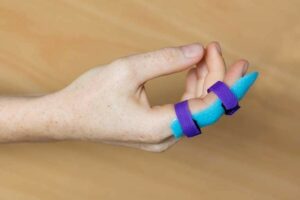
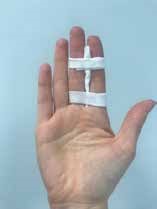
Caring for your injury: Exercises
Please begin these exercises immediately. Try to perform them little and often – at least five times a day.
- With your unaffected hand gently guide your injured finger into a bend as far as pain allow
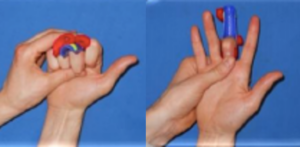
- Hold just below the top joint of your finger and blocking the affected joint bend the tip only as far as you can. Hold for 10 seconds.
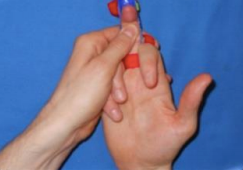
- Bend all fingers down into a fist making sure all three joints bend as far as pain allows. Hold for 5 seconds.
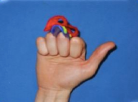
- Make half a fist by bending all the fingers into a hook shape. Hold for 5 seconds.
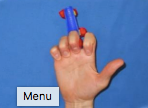
Strength
You can do some simple exercises to help increase strength. Practice up to 3 times a day starting with 5 repetitions, increasing to 10 as able.
Use an elastic band around your fingers to strengthen the muscles in the hand.
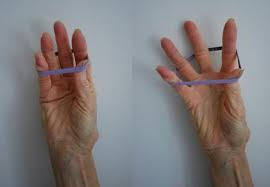
The following pictures show different ball grip exercises. Start with 5 squeezes for each exercise, holding for a couple of seconds. Rest for 2 minutes before completing a further set. Increase the amount of repetitions for each exercise as able.
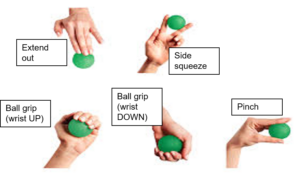
Caring for your injury: Week by Week
0 – 4 weeks
- √ – You can use your injured hand, but not the injured finger for light tasks with the splint and within the limitations of painX – No heavy lifting tasks and contact sports
4 – 8 weeks
- √ – Strengthening and lifting heavy items can gradually increase using pain as a guide
- X – if you are still experiencing significant pain and swelling, then please contact the Virtual Fracture clinic for advice
- X – Avoid heavy lifting and contact sports for 10-12 weeks
Do Not:
Remove your splint.
Get your hand wet whilst wearing the splint.
Grip anything with your injured finger.
You should be able to use your finger for light activities at 4- 6 weeks and you will be able to return to heavy lifting and gripping and sport after 10-12 weeks.
Frequently Asked Questions
I’m concerned about my symptoms and/or I am struggling to return to exercise.
Please contact the Virtual Fracture Clinic.
I am struggling with my strapping/splint. What do I do?
Contact the Virtual Fracture Clinic. You will be referred to the hand therapist who will supervise your rehabilitation.
When can I start driving?
You can return to driving when:
- You can move comfortably
- You can control the vehicle safely
Always test your ability to drive in a safe environment first
How can I get a certificate for work?
You can self-certify for the first 7 days following your injury. For any longer periods, please discuss the provision of a fitness to work statement with the Virtual Fracture Clinic Team or your GP.
How do I contact the Virtual Fracture Clinic?
Call 01582 718121. Messages will be checked every morning Monday-Friday.
Email VFC@ldh.nhs.uk
